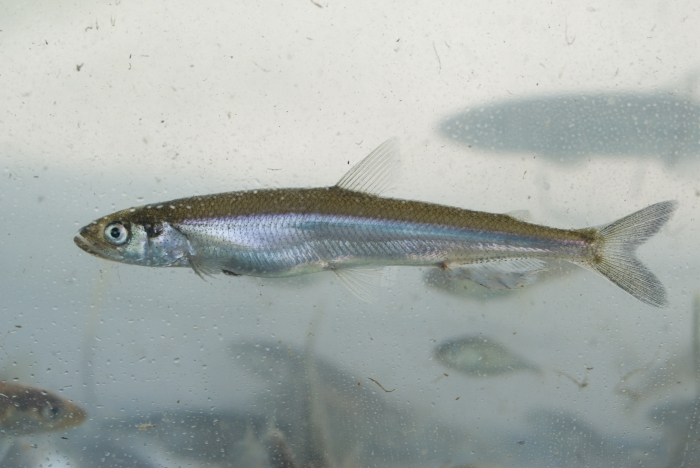
SIZE:
20 to 25 cm, maximum 35.6 cm.
LIFE EXPECTANCY:
Up to 7 years.
LIFE CYCLE:
In spring, rainbow smelt migrate to fresh water to spawn. During the nights between April and June, the female can lay up to 80,000 eggs. These eggs stick to the bottom because of their adhesive envelope. Once born, the rainbow smelt move to salt water to grow. They will return to fresh water for the following spawning season.

Smelt is a small, silvery fish with a large mouth.
Credit: Claude Nozères, photo taken in 2010.
Rainbow smelt has a silvery colour with rainbow highlights on its sides, a white belly and a darker back in shades of green. Its fins are somewhat large and transparent. It has an elongated body with large scales. Its wide mouth extends under the eyes, and it has large and well-developed sharp-edged teeth.
In the water column, usually 150 m depth, but can reach 450 m depth in waters with variable salinity.
Anadromous fish, rainbow smelt are found at the mouths of rivers in winter.
PREYS:
Molluscs
Crustaceans
Marine worms
PREDATORS:
Salmon
Trout
Seals
Seabirds
MACHINES:
- In autumn, gillnet for commercial fishing
- For recreational fishing (the main type of fishing for this species): angling on ice in winter (pêche blanche)
- Dip-net fishing in spring
- Fixed-line fishing, hand fishing and harpoon fishing from wharves in the summer
REGULATIONS:
- Sport-fishing permits required
- Quotas of 60 to 120, depending on the fishing zone
Seven distinct populations of rainbow smelt are found in the waters of the St. Lawrence Seaway. Rainbow smelt found in the southern estuary are classified as vulnerable.
BENEFITS:
Source of protein and fatty acids.
UTILISATION:
Lean white flesh with a finely flaky, soft texture. Its tender bones are also edible.
Rainbow smelt is often eaten whole, pan-fried or deep-fried if it is small. Larger rainbow smelt can also be served whole, en papillote, oven-baked or as a fillet.
OUR CULINARY ADVICE:
- Given its vulnerable status, we do not recommend eating rainbow smelt.
Sweeter during winter
To withstand the cold waters of winter, rainbow smelt accumulate glycerol and an anti-freeze protein in their tissues. These components give rainbow smelt caught in the winter a sweeter taste than those caught in summer.





